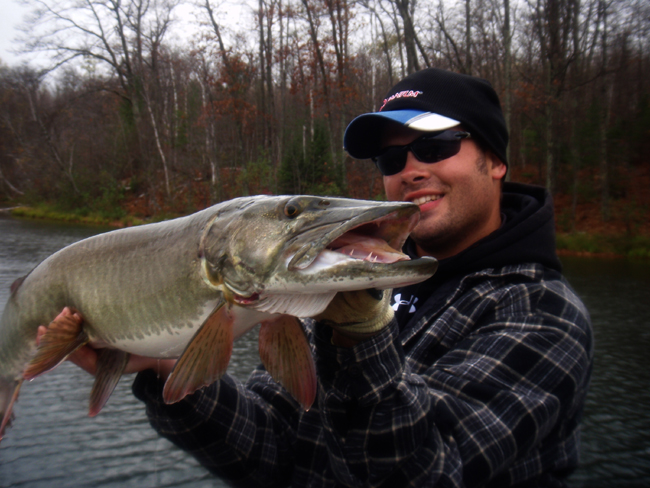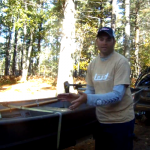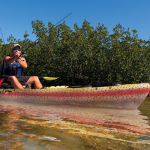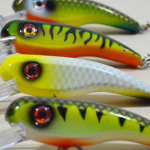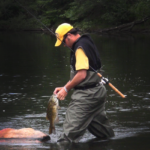By: Andrew Ragas – Date Posted: September 1, 2012
Every once in a while, I receive reader feedback pertaining to past stories, write-ups, video, and photos. One in particular, which was received earlier this morning, is my underwritten topic concerning the catch and release aspect of musky fishing. The procedure of a quick catch-photo-release and the necessary care given to the release of your delicate catch is a subject that I have never deeply written about in any of my blogs or articles.
Message received from Bill M. of Massachusetts, as follows:
Proper muskie netting – handling – release process
“I’ve been fishing muskies for years in WI before moving to MA.
A few weeks ago, returned to Iron County Wisconsin and caught a few muskies on a Shimino 4000 FJ spinning reel loaded with 50# Cortland Master… Yep, I’ve been reading your articles on line etc.
Anyway, like I was taught, I netted my muskies, hauled them into the boat where they bashed all over the place, until I could get ‘em settled to remove the lure, take a snap, and release them… one of them took about ten minutes of nursing in the water till he stayed upright on his own and finned back into the depths…. left me thinking, has to be a better way to protect them after netting them.
I looked at your galleries, and noticed how you keep the Frabill net over the boat’s gunnel and control the fish with your left hand wearing a mesh glove and using pliers with your right hand to remove the lure while the fish is in the net still draped into the lake water… has to be easier on the fish.
It would be really useful to shoot a video on your netting-lure removal-fish lift for pix, and release process… it would really promote protecting muskies from being mishandled and injured before release.
Just an idea to consider.”
I could make a video, but usually when I land a musky, my boat is in pure mayhem as we try to stay organized and work quickly with the fish in order to get it back swimming. Instead, all I can do about it is write a response.
Catching and releasing large fish isn’t rocket science. ALL species of fish require different levels and methods of care to ensure successful release. This includes small ones, large ones, and even world records. Because this subject has been written about so extensively by world renown musky experts and anglers of all skill levels, each individual angler’s methods and procedures may differ. The steps and answers you may have read about proper catch and release might have been based upon the angler’s personal experiences and opinion. My procedures of catch and release aren’t much different as they only differ in tactics and style that cater to myself and the survival of the muskies I catch.
In my opinion, there is no right or wrong way to release a fish. The common objective of every catch and release musky angler is to make sure the fish survives being caught, and survives following release. To me, the only methods that matter in the successful release of the catch is minimal handling. This includes avoiding fin damage due to the net and mishaps, never lifting the fish out of water and into the boat for anything but bump board measurement and photograph, and over-excessive photography. During the catch and release procedure, both the angler and fish are on a time limit. Minimal handling and fast, efficient release ultimately prevents delayed mortality (including lactic acid buildup), the silent musky killer, from taking place.
Without making myself look like the musky police, and to give readers a better understanding of how I quickly and carefully get my fish back into the water without harm, I would like to share the most common steps I do to ensure the adequate release of these freshwater sea monsters.
Be prepared. Have a plan.
1 – Minimize fight. Net head-first.

51 inch musky netted with Frabill Pro-Formance Net – Teardrop Tangle Free Weighted Nylon.
Muskies are frequently lost at boatside due to improper netting. Likewise, muskies can also be harmed when poorly netted as, depending upon net type and material, fish are prone to tangle themselves thus making hook removal increasingly difficult. This is frequently common in cheap aluminum and mesh nets that offer fish and their fins ZERO protection as they thrash themselves around in the bag.
Mesh nets are awful. Burn them or dispose at your convenience.
A good net job is the first step to ensure a good release, and both steps work together hand in hand. A good net job is as good as a successful release. Be in control of the fight and the way you will handle the fish. Always net the fish head first as it minimizes hook and fish tangles, and prevents fin and bodily damage. Until the fish is completely unhooked and ready for quick photograph, always keep it in the water.
For anglers who wade rivers to muskies, leave the nets in your boat, for they are unnecessary. A Boca Grip or any comparable fish gripping tool is efficient and essential for a good landing job as the fish can still be kept in the water at all times.
2 – Have ALL release tools available, and conveniently located.

Majority of my musky fishing takes place in boat. Sometimes it also takes place while wading rivers and shallow lakes. I always keep my release tools conveniently located within arms reach of my casting deck, or in a small carry on bag while I wade.
Such tools to consider for musky fishing are long-nose pliers, needle nose pliers, bolt/hook cutters, jaw spreaders, and handling gloves. With the exception of handling gloves, all of these tools should be requirements to have.
The worst mistake any catch and release musky angler can make is not having these tools available for hook removal. Being unprepared is every angler’s worst nightmare.
Without pliers, the fishes jaws may become damaged during hook extraction…… Without a good pair of bolt cutters such as Knipex ($45+), that fish might as well die from hooks penetrating through its gills….. And without jaw spreaders, good luck accessing past the fishes sharp jaws in order to reach into its mouth.
All of these tools are kept in my boat at all times. I even bring them with when wading too.
You will notice that I frequently sport a handling glove on either my right or left hand as I remove hooks and then pose for a photo. Although they aren’t bullet-proof towards sharp hooks and preventing hook injuries from taking place, they are important to me as they preserve my hands and prevent me for receiving cuts against sharp teeth and gill rakers. If these gloves come with palm and finger grips, they may aid you in holding and gripping the fish. However, usually the slimy nature of muskies will deny you of that. For those of you interested in handling gloves, I recommend the Bass Pro Shops “Offshore Angler” brand which are available in different sized pairs for $10.
3 – Keep fish in water at ALL TIMES during hook removal. NEVER bring into boat.

ALWAYS keep the fish in the net, and in the water during hook removal. Who knows how long it can take to remove hooks….. It can happen either instantly in seconds, or in minutes. The worst thing anglers can do is to bring the entire fish into the boat and drop it to the floor and let it thrash and beat itself up while you struggle you extract hooks. By doing so, injuries will happen to not only the fish but yourselves.
By keeping the fish in water during hook removal, stress to the fish is minimal and almost nonexistent in comparison to if it was flopping on the boat’s floor.
With all hook removal aside, two of the biggest stressors to muskies are warm water temperatures (75 and up), and big waves. Warm water greatly contributes to delayed mortality, and this is lethal to fish that have been stressed from a prolonged fight and difficult hook removal. Fish handling should always be minimized, but when surface temperatures exceed 75 degrees, it can be lethal to muskies as lactic acid has a propensity to build up within the fish, thus resulting in death. In addition to warm temperatures, waves pose a problem as well. Large waves stress muskies because in these conditions it’s difficult for muskies to maintain their surface equilibrium during revival and release.
A quick boatside hook removal leads to a faster revival and safe release. Outside of some photographs and bump board measurements, there is absolutely no reason why any muskie should leave the water for the interior of your boat.
4 – Quick photo.

Have a photographer be ready with camera before you are ready for a photograph with the fish. If fishing by yourself, have a self-timer camera tripod system conveniently set-up in your boat. Keep the delicate fish out of the water for not more than 10 to 20 seconds…. Or in certain adverse conditions such as warm surface temoeratures, don’t bring them out of water at all….. Have your photographer snap away by taking several candid shots along with the one money shot. When ready with the fish, pose for the classic shot before proceeding onto the revival and release.
Unless you really wanted to be blasted by the musky police and then be frowned upon (yes they exist and it does happen lots), NEVER hold fish vertically by jaws or gill plate, hanging from a stringer, gaffe or gripper tool. Hold muskies horizontally or at the very most a 60 to 75 degree angle, always supporting the fishes weight with your free non-gripper hand.
5 – Patiently revive fish. Flow oxygenated water through its gills until it swims away.

This is the last step for a successful release.
Remember to hold the fish steady and straight by the tail with one hand and using the other to gently balance under its belly. Be patient. Regardless of water temperatures and conditions, always revive it before letting it go. Sometimes muskies will swim away instantaneously while other times the revival can take up to 10 minutes or more.

Slowly move the fish back and forth to ensure its gill plates are moving and absorbing oxygen. When the fish retains its strength and maintains its upright position, it becomes ready to let go. Let the fish tell you when it’s ready to swim away before reaching any assumptions that it is. When the pectoral fins and tail begin powering again, you are free to let it go so it can grow.

In our freshwater lakes and rivers, muskies are at the top of the food chain and one of the meanest and most elusive predators swimming around. This is why many anglers cherish catching them. But when in the presence of anglers, and captive in nets, they become fragile, delicate fish.
My goal with this post is to get readers and musky anglers of all skill levels familiar with an adequate and successful catch and release procedure for muskies. With angler awareness and education, the quality of fisheries improve, and the health of caught and released muskies are maintained.


